30 Jun 2011
Summer Treats in Saint Louis
Opera Theatre of St. Louis has demonstrated yet again that it is an indispensable summer festival to be counted on for adventurous programming, thought-provoking productions, and exciting talent discoveries.

Opera Theatre of St. Louis has demonstrated yet again that it is an indispensable summer festival to be counted on for adventurous programming, thought-provoking productions, and exciting talent discoveries.
Never a company to shy away from challenges, this summer’s risk-taking resulted in a stunning new production of John Adams’ The Death of Klinghoffer. Since its 1991 debut, Mr. Adams’ opus has had a somewhat rocky, even notorious history. Never has it seemed more topical, all the while it remains highly controversial. Consider the premise: using the actual historical event of a Muslim terrorist group’s heinous murder of a wheelchair-bound elderly Jewish cruise ship passenger as a dramatic springboard, the piece distills that cowardly, vengeful action into a forum for both political sides to lament and document the personal losses resultant from past and present conflict in the Middle East.
That this is a contentious basis for an opera, there is no doubt. But the creators have responded with a gut-wrenching, transformative work of art that promotes dialogue as much as it abhors terrorism. The composer and librettist Alice Goodman successfully walk a fine line by balancing the angry group dynamics motivating socio-political (mis-)deeds, with the real, personal, human cost reaped by those swept up in an unending, violent response to historical forces. Without respect to the Unities, the creators alternate solo scenes (largely monologues) and impressions of the passengers, crew, and attackers on the ship Achille Lauro with haunting choral pieces of aching, sinewy pain and beauty. Indeed, these powerful ensembles are among the very finest moments John Adams has composed to date and here they were performed with ravishing musicality and laser-beam dramatic intensity.
Every Festival has one standout star performance and this year that distinction belonged to the Gerdine Young Artists ensemble for their impeccable work here. This exceptional training program is not only the heart and soul of OTSL, it is its raison d’etre. Season after season young singers are developed in a nurturing yet intensive program that not only enhances the work at hand but invests in the future. Just check out the program and see how many 2011 principals began their association with OTSL as apprentices. A remarkable success story. The solid work was matched by an exciting roster of soloists.
Nancy Maultsby as Marilyn Klinghoffer wins our hearts, as she must. She has been given a marvelously varied scena to close the show, its vocal demands as wide-ranging as its emotions which span anguished loss, unbridled anger, and hopeless resolution — a potent distillation of Middle East truth and consequences in one, unbearably intense Geschrei. Ms. Maultsby is possessed of an uncommonly rich mezzo, unwavering at full dramatic force, and meltingly responsive in the role’s legato passages. (Coincidentally, Nancy is a former Gerdine Young Artist.)
Christopher Magiera displayed a suave lyric baritone which he put to fine use as the insightful, tormented Captain. In he title role, Brian Mulligan excelled in his dynamic solo moment. Adams makes us wait a long time for Klinghoffer to have his say, and when he did, Mr. Mulligan made it well worth the wait, as he determinedly took the stage with his intense, commanding baritone. Paul La Rosa effectively doubled as a tremulous First Officer, then an unrelentingly determined Rambo, pinging his powerful baritone off the back wall. And, strapping in his wife beater tee shirt, Mr. La Rosa also managed to out-Gunn Nathan in the Muscles Parade. Tenor Matthew DiBattista’s effective Moigi pinned our ears back with ringing, secure high notes. Laura Wilde’s clear, throbbing mezzo made a fine case for Omar’s stirring monologue.
First among equals was arguably Aubrey Allicock, whose distinctive bass-baritone rolled forth with chilling effect and complete assurance. Mr. A is singer with a great gift and great potential. Without reverting to stereotypes Lucy Schaufer created three diverse characters as the Swiss Grandmother, Austrian Woman, and British Dancer. Her polished mezzo and confident acting made each turn highly individual.
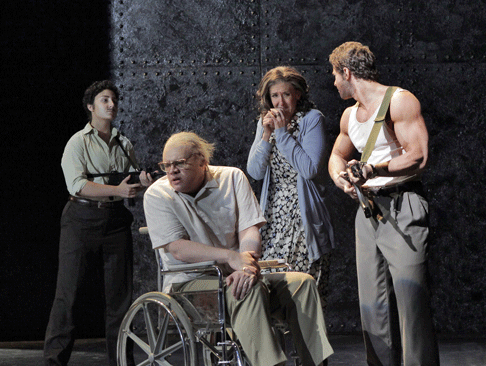 (L to R) Laura Wilde as Omar, Brian Mulligan as Leon Klinghoffer, Nancy Maultsby as Marilyn Klinghoffer, and Paul LaRosa as Rambo
(L to R) Laura Wilde as Omar, Brian Mulligan as Leon Klinghoffer, Nancy Maultsby as Marilyn Klinghoffer, and Paul LaRosa as Rambo
Michael Christie led a tightly controlled and stylistically diverse reading of this unfamiliar piece, managing at once to make it both challenging and accessible. Adams’ usual throbbing rhythms and melodic angularity are tempered with long stretches of undulating, rippling aural effects that suggest the sea. And there are moments of great repose, reflection, and resolution that are unique (in my experience) in the Adams canon. The first rate instrumentalists responded in turn with force, incisiveness, delicacy, and spontaneity.
The design team provided a performing environment well nigh unto perfect, stylized and simple. The varied, ever shifting projections (fine work by Greg Emataz) evoked the sea and eternity all at once. The show began in silence with a bone-chilling image of an empty wheelchair, down lit with a harsh white-hot spot. After a sudden, sharp retort of rifle fire, a torrent of water gushed down from above, brutally pummeling the chair.
The movable wall panels suggested the hull of a ship with expert texturing and a trim of rivets. Carefully selected set pieces and exquisite lighting from Christopher Akerlind were all that was needed to work theatrical magic and create diverse locations. James Schuette’s detailed and evocative period costumes were highly effective.
James Robinson’s direction of the chorus was superb to say the least. His masterful use of the simplest of props, suitcases in this case, first establishes that they are Palestinian refugees. By turning the cases and setting them on end as headstones, we are effortlessly transported to a Jewish cemetery. And in a brilliant stroke, they were piled up to create a wall/settlement that spoke volumes about the physical and social barrier that exists to this day.
Mr. Robinson also blocked his soloists exceedingly well, more often than not trusting them to be physically still as they delivered monologues rife with sub-text and inner life. Having the invalid Klinghoffer stand and deliver his final solo while his wheelchair, hooked to a fly line, ascends to the loft was yet another indelible moment.
The Death of Klinghoffer was of a quality and significance that it would be at home on any world stage. One minor quibble: I dearly wish that cast and conductor had continued the mood through to a sober curtain call. Audience approval prompted big, happy smiles from a few and I wasn’t ready to smile just yet.
The Adams was decidedly not the only treat to be savored. The Festival’s lone comedy proved to be a delectably frothy The Daughter of the Regiment. Director/choreographer Sean Curran skillfully served up a lavish dessert buffet of a show without over-dosing on sweetness. Mr. Curran managed this by mixing in a hint of starch and a dash of cynicism, and by staging the whole with musical comedy precision and savvy. The spot-on ballet goofs that he created for Marie and a corps of (real) dancers to open act two, was a refreshing addition. If the leading characters spoke their lines with just a twinge of Dudley DoRight, operatic-singerly declamation, well, they landed the jokes without fail so it didn’t seem to matter.
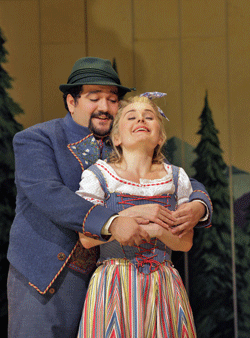 (L to R) René Barbera as Tonio and Ashley Emerson as Marie
(L to R) René Barbera as Tonio and Ashley Emerson as Marie
James Schuette came up with a jewel box of a set design, and vibrant costumes, the whole shebang being persuasively “old-fashioned” down to having a circle of footlights created from halved military snare drums. Rarely do you get to experience such a loving recreation of a bygone production style, utterly free of irony or condescension. Christopher Akerlind devised yet another clean lighting design.
Daughter is one of those operas that can make an impression whether as a showcase for leading world stars (Sills, Sutherland, Dessay, Pavarotti, Florez) or up-and-coming talent such as St. Louis fielded with the wonderfully paired Ashley Emerson (Marie) and René Barbera (Tony).
Ms. Emerson has a crystal clear, pliable coloratura instrument which she skillfully negotiates with assurance and panache. Her forays “in alt” were reliably steady, and her silvery soprano carries well. Ashley is also possessed of a winning presence and she gamely pulls off every comedic turn that is asked of her. If she does not yet have the final measure of poignancy in her Act One farewell to the troops, I have no doubt that time and experience will lead her to that skill. And…she is cute cute cute. Blond, lovely, and petite as a Kristen Chenoweth Action figure, Ashley Emerson delivers a star turn.
René Barbera complemented her perfectly, and his warm, sturdy tenor was a perfect fit not only for the technical demands of the role but also for its temperament. There is more to the part than the high C’s after all (which he nailed), and Mr. Barbera’s slightly bearish physique and sweetly expressive face stood him in good stead in winning audience sympathy.
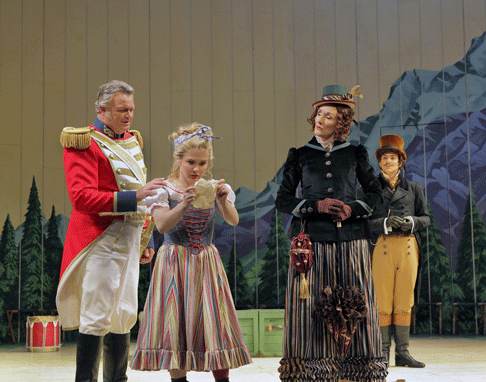 (L to R) Dale Travis as Sulpice, Ashley Emerson as Marie, Dorothy Byrne as the Marquise of Berkenfeld, and Jason Eck as Hortensius
(L to R) Dale Travis as Sulpice, Ashley Emerson as Marie, Dorothy Byrne as the Marquise of Berkenfeld, and Jason Eck as Hortensius
Dorothy Byrne was a glamorous Marquise of Berkenfeld with a more aristocratic mezzo and demeanor than is usual for a role usually essayed by ‘character’ performers. Dale Travis brought years of experience and a sturdy baritone to his broad take on Sergeant Sulpice. Operatic-soprano-turned-cabaret-artist Sylvia McNair gifted us with a well-received Duchess of Crackenthorp, dropping topical punchlines with precision and tickling us with an inserted novelty number about a diva who has a bad sense of pitch.
John McDaniel kept everything bubbling along merrily in the pit. The maestro proved to be a capable collaborator who, with his excellent cast, treated us to an effervescent afternoon. Only the Act Two trio for Marie-Tonio-Sulpice failed to fully ignite, coming off as cautious rather than breathless. Nonetheless, what a succulent confection.
Masterpiece though it may be, Pelléas and Mélisande is never going to be on the Opera Hit Parade. Dark, diffuse, elusive, the Debussy opus resists accessibility. It reminds me of a film of recent years In the Bedroom, in which, save one cathartic event, all of the emotional ‘action’ is under the surface. If you are willing to immerse yourself in Debussy’s musical pallette there is much to be mined. If not, there is always intermission, in which about one quarter of the unmoved patrons chose instead to ‘move’ to the exit.
To their credit, the production team made an earnest effort to make Maeterlinck’s ambiguous tale resonate. Paul Steinberg (Set Design) Constance Hoffman (Costumes) and especially Adam Silverman (Lighting) devised a suitably vague abstract world, a universal playing space peopled by recognizable archetypes. Mr. Silverman’s well-considered area specials and quicksilver lighting changes were models of invention, and Mr. Stenberg’s Marimekko-like green and white leaf pattern on the walls and floor were particularly apt as a constant reference point amid fluid shifts of well-chosen set pieces.
David Alden’s direction proposed that the story veils a hushed-up history of sexual threats and physical/emotional abuse. This jives well with the heroine’s protestations of “Don’t touch me.” It wears less well as the evening progresses, with Golaud becoming more and more relentlessly brutish, and the nerdily dweebish title hero becoming more emotionally paralyzed than Hamlet on downers. Stuck in the middle of these widening poles, poor Mélisande appeared more tediously catatonic by the minute. In the end, by trying to infuse the piece with a specificity out of today’s headlines, Mr. Alden actually made the piece lose its special character which allows each of us to devise our own scenario as to what has happened, and what will happen to the characters in this realm of imagination and speculation.
Stephen Lord elicited well-judged, idiomatic playing from his band. The whole reading had a wonderful, evocative arc that was ethereal, yes, but also explosive on those several occasions that demand dramatic fire. For me, this opera’s language is so specific to the musical texture that it just does not soar in English. Diction was fine, translation was all right, but the vernacular robbed the soloists of those slightly covered vowel sounds that help inform the vocal line.
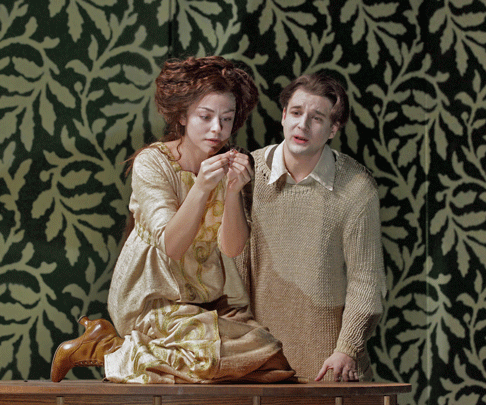 (L to R) Corinne Winters as Mélisande and Liam Bonner as Pelléas
(L to R) Corinne Winters as Mélisande and Liam Bonner as Pelléas
Of the cast, only veteran John Cheek embodied the right “sound” with his orotund, slightly grainy bass in wonderfully plangent form as Arkel. Gregory Dahl’s blustery Golaud found his baritone a bit short of oomph on the bottom which caused him to slightly distort vowels in an effort to inject some heft in the lower reaches. Mr. Dahl’s middle and upper registers rang out convincingly, and his acting as a menacing, tortured soul was wholly persuasive. Maria Zifchak’s stirring tones and commendable control in the brief role of Genevieve left us wanting more from this fine artist. Michael Kepler Meo arguably stole the show as Yniold with his responsive boy soprano and his focused, purposeful acting.
In the title parts, Liam Bonner and Corinne Winters were ‘almost’ all one could wish. Mr. Bonner has at his disposal a smooth lyric baritone which he uses with great musicality. He essays the sustained forays around the top of the staff with considerable skill, although the handful of the very highest forte notes in his final confrontation were just at (though not beyond) the limit of his resources. Ms. Winters for her part showed off a medium bodied lyric with well-honed technique, capable of considerable nuance, and comfortable throughout the wide-ranging part. What both singers lack at this point, alas, is either a unique timbre, and/or the ability to sustain a plaintive vocal appeal that the greatest interpreters brought to the piece (think von Stade and Stilwell).
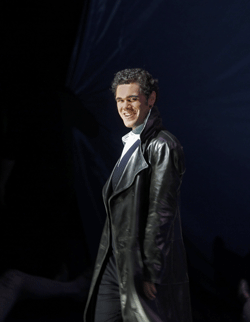 Elliot Madore as Don Giovanni
Elliot Madore as Don Giovanni
Still, what a pleasure to see such a polished mounting of this challenging work, marked by the highest professional standards and characterized by a dramatic interpretation worthy of continued consideration and discussion.
OTSL was slightly less well-served by the roster’s bread-and-butter title Don Giovanni. Not that there weren’t many enjoyable components in it — there surely were. But they stubbornly refused to gel.
Bruno Schwengl’s sets and costumes were all over the place from period fantasy looks to rather bland modern dress. His sets were generally flat-looking, and somewhat confusing. What those two blue boxy sit-’n’-spin playpens were in the scene when the Don first encounters Zerlina is anyone’s guess. The cartoonish plinth for the Commendatore’s statue didn’t partner well with the prone, naked, painted-gray-like-stone dancer who first posed as an inert sculpture then later came to life came to life.
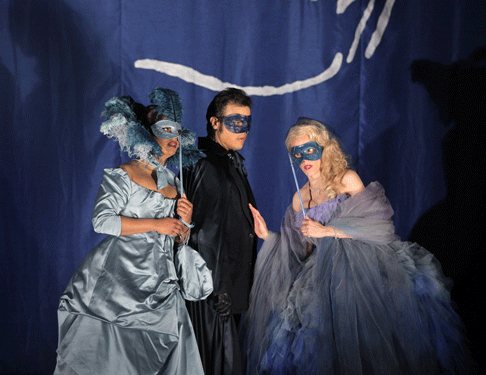 (L to R) Kishani Jayasinghe as Donna Elvira, David Portillo as Don Ottavio, and Maria Kanyova as Donna Anna
(L to R) Kishani Jayasinghe as Donna Elvira, David Portillo as Don Ottavio, and Maria Kanyova as Donna Anna
Nor were the proceedings really helped by James Robinson’s and Michael Shell’s fitful direction, although there were some intriguing ideas put forth that then sadly died on the vine. After visually suggesting at the end of the first scene that Donna Anna and Ottavio are having an aggressively active sex life, the concept is never developed. After Leporello starts the show by turning upstage and taking a leak on the wall at overture’s end, that irreverence never takes hold, and rather descends into a tiresome series of frat boy jokes and boorish behavior which endears us to neither of our two Bad Boyz. A rather promising device of having spectral supers haunt Giovanni’s misdeeds is sporadically potent, although when they strip him of his earthly trappings before throwing him into hell, they demurely stop after the shirt. If you’re going to set up the expectation of that imagery, then take it all off, baby!
The staging tripped over its own good intentions, leaving a cast of fine singers to interact with each other without really bonding. The relationship between Leporello and his master was particularly un-engaging, all rough and tumble surface macho posturing. Levi Hernandez has all the goods for a fine Leporello, mind you, showing us good buffo sensibilities and a solid bass. And boy-band-handsome Elliot Madore has a warm, virile baritone that indeed falls very pleasantly on the ear. But there is more to the Don than a shirt open to the navel, restless swaggering, making ‘sexy’ faces, and arching the eyebrows. Elliott, don’t just do something, stand there! And let it emanate from within.
Maria Kanyova was wholly successful as Donna Anna, her reliable, gleaming soprano giving much pleasure. But her acting seemed to be more about technique than inner fire on this occasion. Maybe I was just distanced by her puzzling blond wig (although Ashley Ryan contributed otherwise outstanding hair and make-up design for all four pieces). David Portillo was a marvelous Ottavio, with good starch in his character and a honeyed lilt in his tenor. Although deprived of “Dalla sua pace” he scored a bullseye with “Il mio Tesoro” (or whatever they were in English). While Kishani Jayasinghe has not just yet solved every challenge of Donna Elvira (the opera’s most complex role), she treated us to many exciting moments with a golden, even soprano that had hints of Freni. Andrew Gangestad was an imposing Commendatore with a penetrating bass.
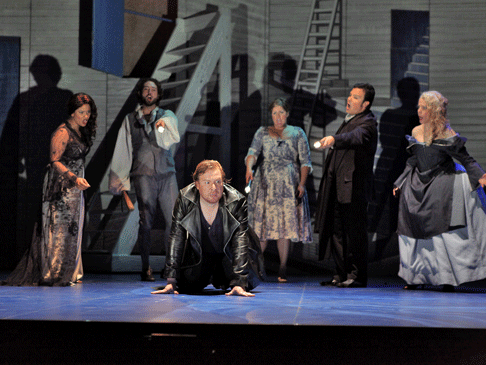 (L to R) Kishani Jayasinghe as Donna Elvira, Bradley Smoak as Masetto, Levi Hernandez as Leporello, Kathryn Leemhuis as Zerlina, David Portillo as Don Ottavio, and Maria Kanyova as Donna Anna
(L to R) Kishani Jayasinghe as Donna Elvira, Bradley Smoak as Masetto, Levi Hernandez as Leporello, Kathryn Leemhuis as Zerlina, David Portillo as Don Ottavio, and Maria Kanyova as Donna Anna
The two Mozart stand-outs for me were the fresh-voiced Zerlina from animated mezzo Kathryn Leemhuis, and the robust Masetto from Bradley Smoak. Ms. Leemhuis was a breath of fresh air: spontaneous, honest, and vocally assured; and Mr. Smoak’s attractive, manly baritone had rich presence and power. Indeed, I believe young Bradley might make a dynamic Don someday, sooner rather than later.
Since I so greatly admire Maestra Jane Glover, I wish I could say that the musical reading was at her usual high standard. But I found the orchestra while playing cleanly, sounded dry; and while the whole was well paced and musically sound, it lacked the inner drive that is so evident in Glover’s finest work.
James Sohre
The Death of Klinghoffer
The Captain: Christopher Magiera; First Officer/Rambo: Paul La Rosa; Swiss Grandmother/Austrian/British Dancer: Lucy Schaufer; Molgi: Matthew DiBattista; Mamoud: Aubrey Allicock; Leon Klinghoffer: Brian Mulligan; Omar: Laura Wilde; Marilyn Klinghoffer: Nancy Maultsby. Conductor: Michael Christie. Director: James Robinson. Set Designer: Allen Moyer. Costume Designer: James Schuette. Video Projection Designer: Greg Emetaz. Lighting Designer: Christopher Akerlind. Sound Designer: Mark Grey. Wig and Make-up Design: Ashley Ryan. Choreographer: Sean Curran. Chorus Master: R. Robert Ainsley.
The Daughter of the Regiment
Hortensius: Jason Eck; Marquise of Berkenfeld: Dorothy Byrne; Peasant: Clay Hilley; Sergeant Sulpice: Dale Travis; Marie: Ashley Emerson; Tonio: René Barbera; Corporal: Matthew Hanscom; Duchess of Crackenthorp: Sylvia McNair; Notary: Kyle Erdos Knapp. Conductor: John McDaniel. Director and Choreographer: Sean Curran. Set and Costume Designer: James Schuette. Lighting Designer: Christopher Akerlind.
Pelléas and Mélisande
Golaud: Gregory Dahl; Mélisande: Corinne Winters; Genevieve: Maria Zifchak; Arkel: John Cheek; Pelléas: Liam Bonner; Yniold: Michale Kepler Meo; Shepherd Voice: Sidney Outlaw; Physician: Allen Boxer. Conductor: Stephen Lord. Director: David Alden. Set Designer: Paul Steinberg. Costume Designer: Constance Hoffman. Lighting Designer: Adam Silverman.
Don Giovanni
Leporello: Levi Hernandez; Donna Anna: Maria Kanyova; Don Giovanni: Elliot Madore; Commendatore: Andrew Gangestad; Don Ottavio: David Portillo; Donna Elvira: Kishani Jayasinghe; Zerlina: Kathryn Leemhuis; Masetto: Bradley Smoak. Conductor/Fortepiano: Jane Glover; Stage Directors: James Robinson and Michael Shell. Set and Costume Designer: Bruno Schwengl. Lighting Designer: Christopher Akerlind.